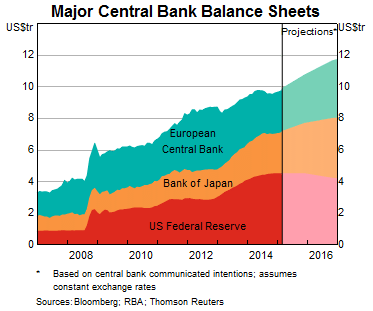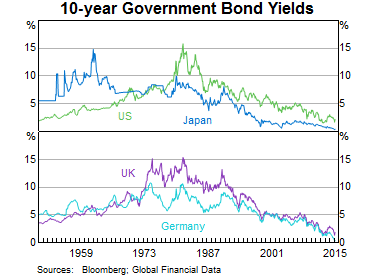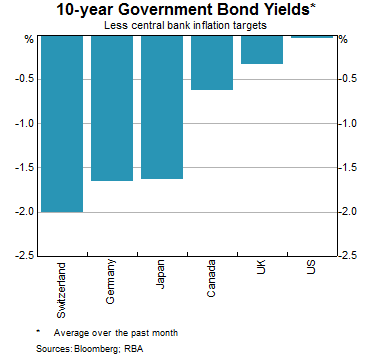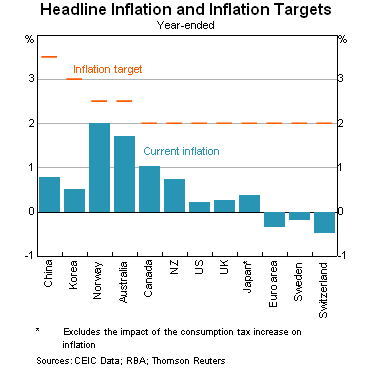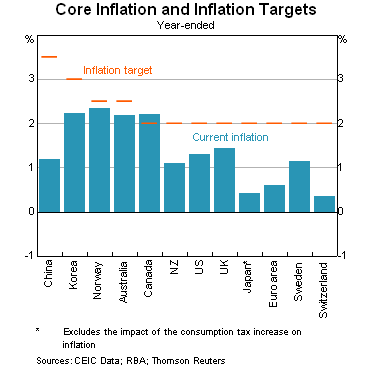Low Inflation in a World of Monetary Stimulus
I would like to thank Goldman Sachs for the invitation to speak today. It is a pleasure to be here and be part of your annual Macro Economic Conference.
It is perhaps stating the obvious to say that an important part of the macroeconomic environment is monetary policy. The actions of central banks have material effects on financial markets and can shape macroeconomic outcomes. Indeed, over recent decades it became widely accepted that monetary policy was the primary macroeconomic stabilisation tool and that monetary policy could effectively manage the business cycle.
From today’s perspective, the picture looks a little different. In many ways, the current global monetary environment is quite extraordinary. There has been unprecedented money creation by the world’s major central banks. Policy interest rates are negative across much of Europe. Long-term government bonds yields in most advanced economies are the lowest in recorded history. Lending rates for many private sector borrowers are the lowest ever. And some banks in Europe are now charging customers to accept deposits.
In earlier eras, one could have predicted with some confidence that this type of monetary stimulus would have created a boom in economic activity and subsequently a substantial lift in inflation. Yet, today, many parts of the world continue to operate with considerable spare capacity, inflation rates are low almost everywhere and inflation expectations have generally declined, not increased.
So this afternoon, I would like to talk a little about these very unusual times. I will begin by showing a few graphs that summarise the current global monetary environment. I would then like to explore some of the possible reasons why we are in this environment before addressing some of the implications of all this for Australia.
The Current Global Monetary Environment
So first, to the facts.
Since the global financial crisis, we have seen an extraordinary increase in the size of central bank balance sheets. This first graph shows the size of the combined balance sheet of the US Federal Reserve, the Bank of Japan and the European Central Bank (Graph 1). This combined balance sheet has increased from the equivalent of US$3½ trillion in early 2007 to almost US$10 trillion today, and a further substantial rise is in prospect. Once this further increase has occurred, the combined balance sheet will be equivalent to around 35 per cent of the relevant countries’ collective GDP, up from just 10 per cent prior to the crisis. This increase has taken place primarily by the central banks creating money to purchase assets outright from the private sector.
Graph 1
The next graph shows a long time-series of nominal 10-year government bond yields for a number of advanced economies (Graph 2). The striking thing is how low these rates are now. The German and Japanese Governments can borrow for 10 years at less than 0.4 of a percentage point, while the US and UK Governments pay 2 per cent or less. At shorter maturities, investors are prepared to actually pay governments to look after their money. And it is not just governments that can borrow at negative rates, with yields on the bonds issued by some highly rated corporations also turning negative recently.
Graph 2
With nominal rates so low, real long-term government bond yields in much of the world are negative. One way of calculating these real rates is to subtract the central bank’s inflation target from the nominal 10-year yield. The results of this are shown in this next graph (Graph 3). If the central banks do achieve their inflation targets (and there is some doubt that this will be the case), the current yields imply very large real losses for the holders of some sovereign bonds. For example, if the Bank of Japan was to achieve its inflation target over the next decade, then current holders of 10-year Japanese government bonds would lose around 15 per cent of their investment in real terms. The same is broadly true in Germany. And in the United States, the real return over the next 10 years would be zero.
Graph 3
The next graph shows current headline inflation rates for a number of countries as well as the midpoint of the relevant inflation target or objective (Graph 4). In all advanced economies, inflation is currently below target and this is also true in quite a few emerging market economies. Of course, one reason for the low inflation rates is the recent large decline in oil prices. But even so, as is evident from the following graph (Graph 5), core or underlying rates of inflation are also below target almost everywhere.
Graph 4
Graph 5
So to summarise briefly, the current environment is one in which there has been a very large monetary stimulus, interest rates are very low and inflation is subdued. This is not exactly what the traditional textbooks would have predicted.
Why do we find ourselves here?
The obvious questions that arise here are why do we find ourselves in this situation and what does it say about the effectiveness of global monetary policy?
One answer is that the current environment simply reflects the extreme nature of the financial crisis and that monetary policy is working pretty much as it always has. In a number of dimensions the crisis was the biggest financial shock since the Great Depression in the 1930s. It led to major stresses in bank and government balance sheets and badly dented confidence. Monetary policy responded to this, with the size of the response commensurate with the size of the shock. According to this line of argument, what is unusual about the current environment is not the magnitude or the effectiveness of the monetary response, but rather the magnitude of the underlying problem to which monetary policy is responding.
An alternative answer is that the effects of monetary policy have been somewhat less, or slower to materialise, than in earlier times. Partly as a result of this, the monetary response has needed to be larger. This line of argument recognises the considerable damage caused by the financial crisis, but sees economic activity and inflation responding in only a relatively muted way to the monetary stimulus, with central banks having to do more to achieve their mandated goals.
There is probably an element of truth in both of these answers. The shock caused by the financial crisis was indeed a very large one and a very large monetary response was appropriate and helpful. At the same time, though, the transmission of the monetary stimulus does look to have been a little different through this episode. Economic activity does not appear to have responded to the stimulatory monetary conditions in the way that occurred in the past and inflation rates have been very low.
Perhaps the single most important factor explaining this is the very high levels of debt that exist in many advanced economies.
To read the rest of this speech, please click here











